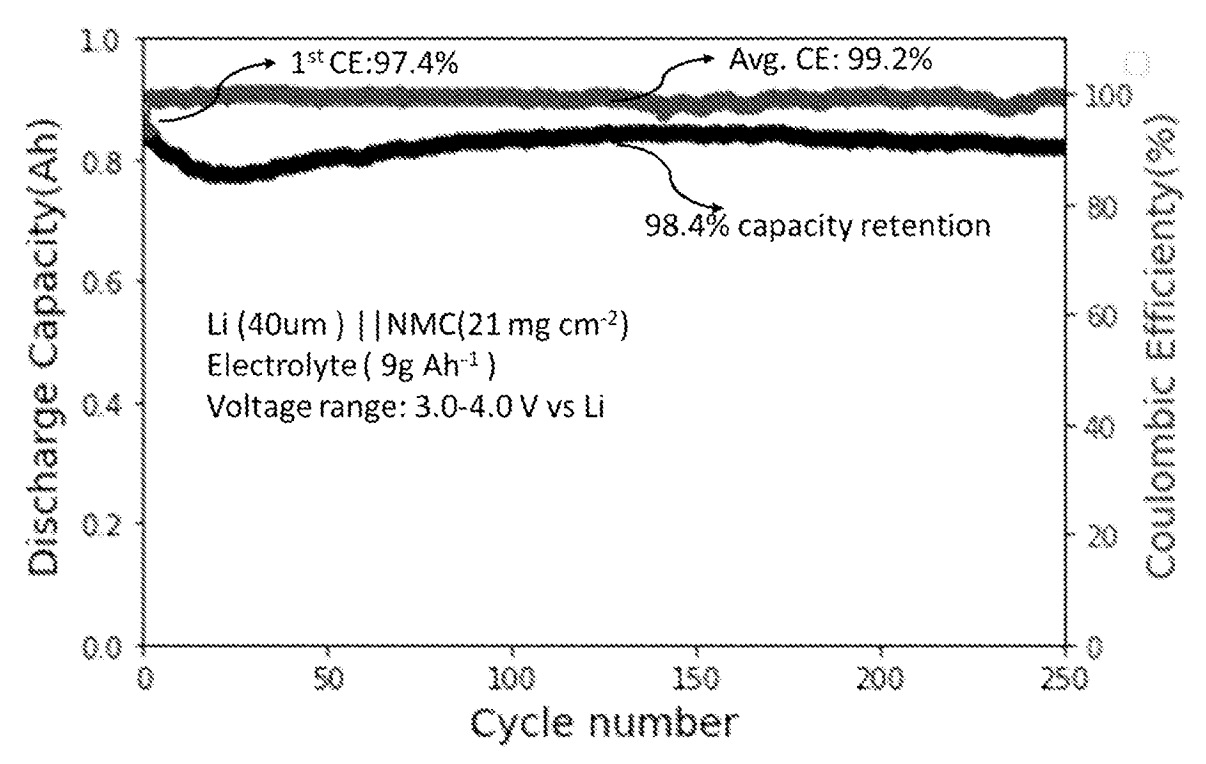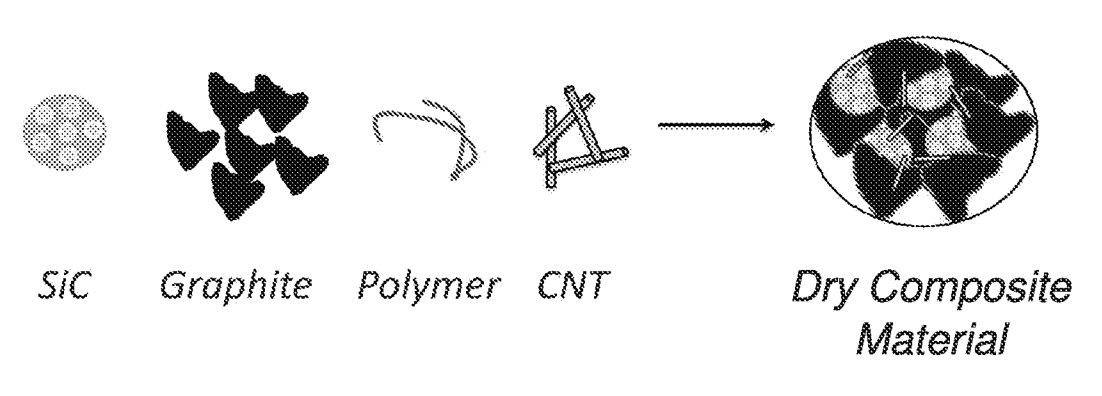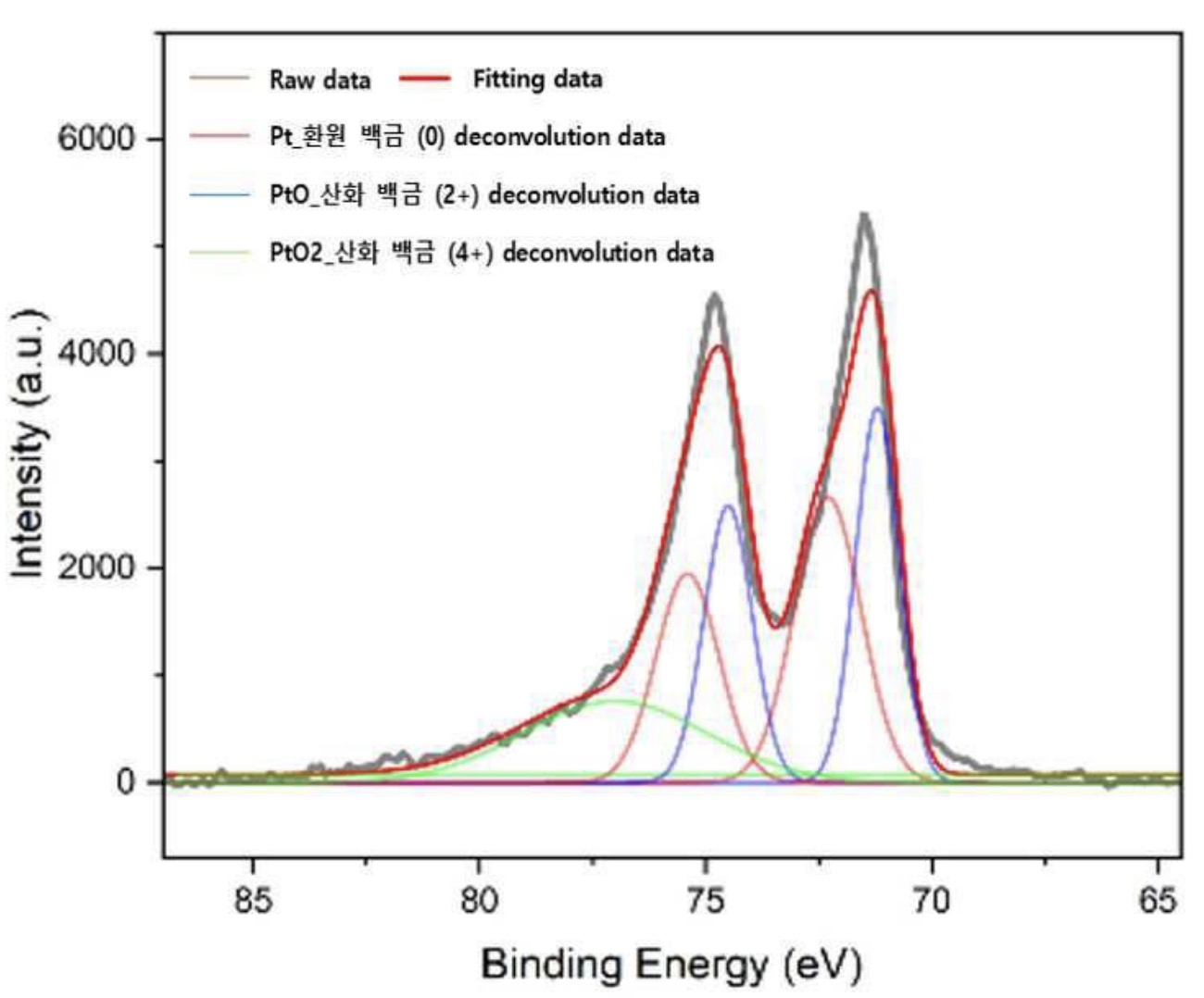-
Lithium-ion batteries – electrolytes – solid & semi-solid
-
A Li / NMC622 pouch cell (0.8 Ah) was fabricated using a double-side coated
separator. The separator comprises a polyethylene base membrane (9 μm) coated on both
sides with a blend of LLZTO (Li6.4La3Zr1.4Ta0.6O12, particle size: 500 nm) and polyethylene oxide (90 : 10 by mass, thickness not identified).
One pouch cell contains 9
layers of NMC622 positive electrodes (20.5 mg/cm2) and 8 layers of lithium metal
negative electrodes (40 μm).
The electrolyte comprises lithium bis(fluorosulfonyl)imide (LiFSI, 1 M) in dimethoxyethane
(DME) / 1,1,2,2-tetrafluoroethylene-2,2,3,3-tetrafluoropropyl ether (TTE)
(1.2 : 3 molar ratio).
Cells exhibit a first cycle efficiency of 97.4% and 98.4%
capacity retention after 250 cycles (0.33 C charge / discharge).

This work illustrates promising cycling stability in a semi-solid cell design with a solid layer facing the lithium metal negative electrode on one face
and a liquid electrolyte-filled porous separator on the other face.
Presumably, the liquid electrolyte will be replaced by an optimized mixture that might contain higher-boiling components for improved inherent safety
characteristics.
-
The premium version includes another two patent discussions, plus an Excel list with 50-100 commercially relevant recent patent families.
-
Lithium-ion batteries – negative electrode (excluding Li metal electrodes)
-
A dry composite material was prepared by mixing a silicon-carbon composite material (5 mass%, see Figure), graphite (94.75 mass%), and single-walled carbon nanotubes
(SWCNT, 0.1 mass%) with carboxymethyl cellulose (CMC, 0.15 mass%) in water. The slurry was mixed (800 rpm, 2 times 365 s), then diluted
to achieve 40% solid content and a viscosity below 400 cp. Spray-drying was performed (210°C inlet temperature).
The dry composite material exhibits a median particle size (D50) of 16.9 μm and a BET specific surface area of 1.31 m2/g.
Negative electrodes were fabricated by mixing the dry composite with polytetrafluoroethylene (PTFE, 2 mass%) and polyvinylidene fluoride (PVDF, 0.5 mass%),
followed by calendaring to achieve 15.0 mg/cm2 loading and 1.45 g/cm3 density. In half-cells, the electrodes exhibit a discharge capacity
of 409.4 mAh/g with 90.5% first cycle efficiency. Full cells with NMC811-based positive electrodes
retain ≈95% capacity after 100 cycles at 40°C (C/20 charge / discharge).

This work suggests that Tesla is evaluating Si-carbon composite / graphite active material combinations in the context of its
dry negative electrode fabrication process.
Possibly, an insufficiently homogeneous micro- & nano-scale distribution of the different components was obtained in the absence of carrying out
a separate spray-drying 'pre-mixing' procedure.
-
The premium version includes another two patent discussions, plus an Excel list with 50-100 commercially relevant recent patent families.
-
Lithium-ion batteries – positive electrode
-
Lithium methanesulfonate (0.1 mass%) was added to a cake-like composition of NCA (nickel cobalt aluminum)
active material, followed by a heat-treatment (180°C, 2 h). Fourier transform infrared spectroscopy (FT-IR) confirmed the presence
of methanesulfonate on the secondary particle surfaces (0.1 mass% residual lithium methanesulfonate content).
The dry electrode manufacturing process consists of three main steps:
1) A mixing step where active material particles, acetylene black, and
polytetrafluoroethylene (PTFE) binder were combined in a mass ratio of 100 : 1 : 2 using a
Wonder Crusher mixer (Osaka Chemical, 5 min, room temperature) to
form a positive electrode mixture.
2) An extension step where the mixture was passed through dual rollers with a peripheral
speed ratio of 1 : 3 to form a sheet with ≈100 μm thickness.
3) An attachment step using rollers heated to up to 300°C with a line pressure of 1.0
t/cm to bond the electrode sheet to the aluminum current
collector.
The PTFE concentration across the electrode thickness varied from 32-35% from current
collector side to surface, indicating relatively uniform
distribution without localization.
This work suggests that Panasonic also targets dry positive electrode manufacturing,
employing a small amount of lithium methanesulfonate for processability reasons and
to optimize electrode wettability with electrolyte.
Achieving a sufficiently homogeneous PTFE distribution is of key importance and
will have to be maintained upon further up-scaling.
-
The premium version includes another two patent discussions, plus an Excel list with 50-100 commercially relevant recent patent families.
-
Fuel cells (PEMFC / SOFC / PAFC / AEMFC) – electrochemically active materials
-
A carbon support and a platinum precursor were mixed with ethylene glycol. Formalin was added
to this mixture (0.5-1 molar ratio relative to platinum).
The mixture was heated (100-170°C, 1-5 h), followed by a surface treatment to stabilize the
platinum particles (no details identified). The product was filtered to obtain a cake-like catalyst.
The catalyst cake was repeatedly dispersed in water and filtered for washing. After drying under
nitrogen atmosphere (100-180°C) and grinding, a powder catalyst was obtained.
The powder exhibits a particle size of 2.3 nm, a reduction rate of 39.6% (see Figure), a platinum active area of
77.5 m2/g, and an MEA (membrane-electrode-assembly of PEMFC) performance of
0.60 V@1A/cm2 (65°C, use as cathode and anode catalyst), as compared to 2.3 nm, 28.1%, 71.2 m2/g and 0.55
V@1A/cm2 for a comparative catalyst in which hydrazine was used as reducing agent.

This work illustrates that Pt oxidation state tuning is feasible with formalin as to allow for favorable PEMFC catalyst performance.
-
The premium version includes another two patent discussions, plus an Excel list with 50-100 commercially relevant recent patent families.
-
Triweekly patent lists for other categories (Excel files are included for premium users)
-
- Lithium metal containing batteries (excluding Li-S, Li-Air): XLSX
-
- Lithium-ion batteries – electrolytes – liquid: XLSX
-
- Lithium-ion batteries – separators: XLSX
-
- Lithium-sulfur batteries: XLSX
-
- Metal-air batteries: XLSX
-
- Na-ion batteries: XLSX
-
Prior patent updates
-
2024-11-12
-
2024-10-22
-
2024-10-01
-
2024-09-10
-
2024-08-20
|